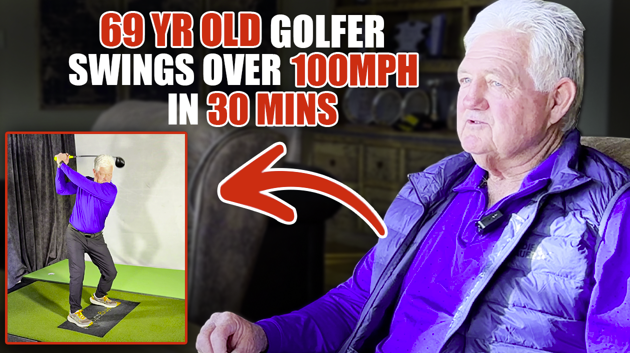The first step to great chipping technique is a perfect setup.
If you haven't mastered the chipping setup yet, now is the time to go back and really work through that lesson. Make sure your setup is perfect before you start on this lesson because you won't be able to use proper chipping technique if your setup is wrong.
Once you have a great setup, chipping becomes very easy. The stroke itself is quite simple and can be broken down into four basic pieces:
- Weight distribution
- Arm movement
- Shoulder movement
- Left wrist position
If you get a good setup and do those four pieces correctly, you will be a great chipper.
Key 1: Weight Distribution
The first thing we're going to talk about is weight distribution. As we've mentioned in other lessons, your weight distribution affects where the swing bottoms out.
With the chipping stroke, you want to keep about 70-80% of your weight on the left side. Imagine your weight in your left heel, and keep it planted there throughout the entire stroke.
You can almost imagine the left hip as your anchor or pivot point. Just rotate back and through, around that left side.
Letting the weight shift is one of the most common mistakes we see in poor chippers.
If you shift your weight to the right side and try to make some swings, you'll find that your club grounds out farther to the right. As you shift to the left, the bottom of the swing arc will ground out farther to the left.
Keeping your weight constant keeps your impact position and the bottom of the swing arc constant, making it very easy to hit nice, crisp shots.
Keeping your weight on the left side is the first key to a great chip shot.
Side Note: Staying Relaxed
Related to both weight distribution and arm movement is the importance of keeping your lower body very soft in the chipping stroke. This allows your body to move more fluidly and for the proper chipping technique to happen more naturally.
Imagine casually tossing someone a ball. Your body would stay very loose and relaxed; you wouldn't get all rigid and try to guide the ball like a robot or a machine. You can just sense that that's not how your body is designed to work.
Your knees may move a little, and of course your arms move when you toss a ball, but overall your body stays nice and relaxed.
When you make a chipping stroke, it's very important to stay just as loose and relaxed. If you tense up and try to guide the club with stiff arms, you end up feeling like a robot and it makes everything more difficult.
If you've ever tossed a ball around or practiced a sport that involved throwing or hitting a ball then you've already been training for the chip shot. Just tap into your existing athletic ability and your natural sense of how this should feel.
Key 2: Arm Movement
Your arms don't bend a lot with the proper chipping technique. As you can see in the photo, they stay fairly straight. Don't go to the other extreme and lock your elbows or tense up your arms - just keep them nice and straight.
A lot of golfers want to fold up the right arm then flip a lot at the bottom of the swing, but moving your arms all over the place and getting a lot of wrist action will just make your swing very inconsistent, with the club moving all over the place.
The arms stay nice and straight, and just rock back and through. It's a very simple motion, somewhat similar to a putting stroke but a little bit longer and with a little more arm action than a putt.
That said, again you don't want to lock your arms or tense them up and hold them perfectly straight. Just keep them fairly straight, with wrists and arms very relaxed. You'll get just a little bit of wrist action swinging back and through, allowing the club to hinge just a little bit.
Keeping the club nice and soft in your hands gives you a good feel for the shot; soft hands can judge the distance much better than tense ones.
Key 3: Shoulder Movement
Your shoulders should be down and back in the chipping stance. Like the arms, they will rock gently back and through, and should not be stiff or tense.
The biggest problem we see with chip shots is that many golfers have been taught a "straight back, straight through" technique, where the shoulders rock up and down. Doing that shifts your spine all over the place, curving it away from the target as you shift back. That's not what we're trying to do here.
You want your shoulders to rotate around your spine. Your spine angle remains constant throughout the chipping stroke, with the shoulders making a gentle pivot around the spine.
There will be a little bit of rotation in the shoulders as you go back and through, but you're not getting a great big turn and ripping the shoulders through. Most importantly, again, the shoulders turn around the spine instead of working against it.
Proper shoulder movement will help you develop a much more consistent chip shot. Everything becomes easier when you use your body the way it's actually designed to work.
Key 4: Left Wrist
The fourth piece of a great chipping stroke is the left wrist.
As you're chipping, bow your wrist slightly so your wristwatch leads the way and the logo on the back of your glove points down at the ground. Your wrist should stay a little bit bowed through impact.
As we mentioned in an earlier lesson, when people get into poor setup they often start to flip, adding loft to the club and pushing the club head forward. If you do that, you'll find that the logo on the back of your glove will end up pointing up at the sky. That is incorrect.
You want to make sure that logo points down at the ground. Keep the wrist nice and loose and slightly bowed toward the flag. The logo should be pointing at the flag as you complete the chipping stroke.
Start Slow
As always, start drilling this chipping technique in slow motion. Don't even worry about hitting a ball; just go ahead and make the correct movements to get a feel for it.
As you become comfortable, put all the pieces together for a nice, simple stroke. There aren't a lot of moving parts involved in the chipping stroke. It's fairly simple stuff. The shoulders rock a bit. The knees move some, but not a whole lot. Everything stays nice and loose.
Work on your setup, master the technique described here, and then just start playing and working on your short game. You'll be getting up and down more than you ever have before.
Watch part 2 now to see how you're moving your body in the opposite direction of the pros!


































































































































































































































































































































































































































































































